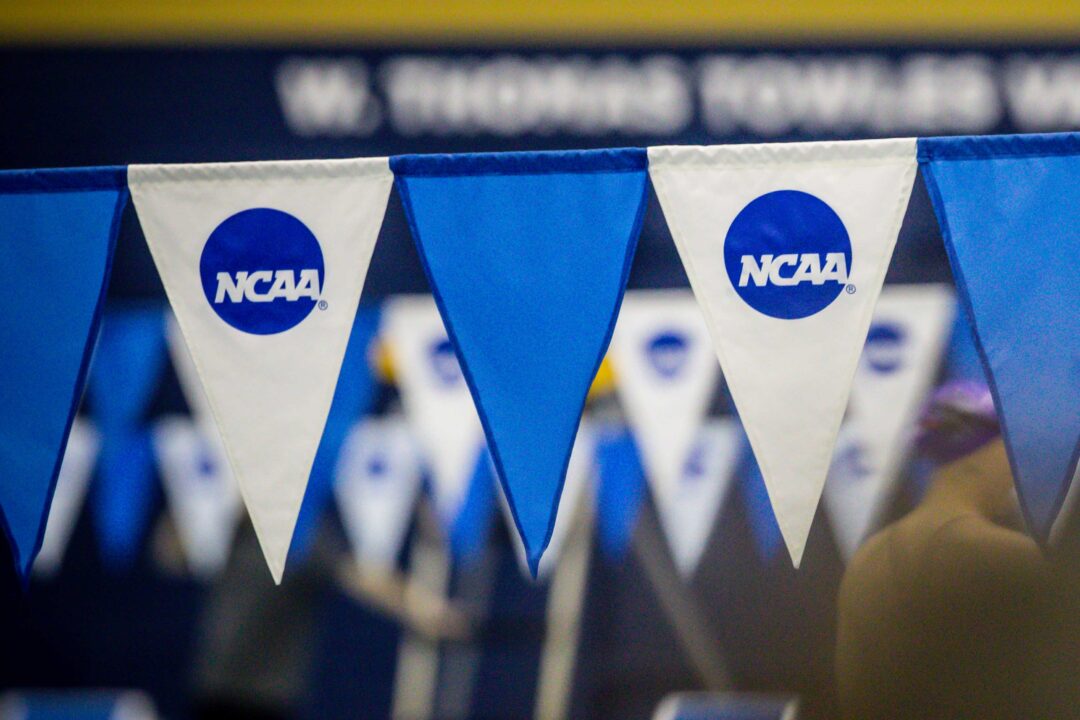After we reported yesterday how the SEC and Big Ten were discussing new roster limits, the NCAA is now reportedly set to eliminate scholarship limits across all sports beginning in the 2025-26 season.
According to Yahoo Sports, the new revenue-sharing model will see by-sport scholarship restrictions eliminated, allowing schools to offer scholarships to the entirety of their rosters.
New roster limits won’t be final until the approval of settlement terms in the House case, but in swimming & diving, the limits are expected to be 23 men and 35 women, at least in the SEC and Big Ten.
The elimination of scholarship limits comes as the House case settlement opens the door for schools to pay student-athletes NIL money, and therefore, it wouldn’t make sense for there to be only a certain number of scholarships available when the other athletes could still earn money through NIL.
During a meeting on Tuesday involving the power conference commissioners, new roster limits for football were reportedly set at 105, meaning there will be a 20-scholarship increase compared to the current limit which is 85.
Baseball, which has a scholarship restriction of 11.7, is expected to have a roster cap of 34, while softball and volleyball are expected to have roster limits of 25 and 18, respectively, a stark increase from their current scholarship limit of 12.
Another change is that all sports will now be considered “equivalency sports,” meaning partial scholarships can be distributed to all athletes. Previously, sports such as football and basketball were considered “head-count sports” requiring players on scholarship to receive a full grant.
Schools won’t be required to use scholarships for all of their roster spots, leaving room for walk-on opportunities.
Yahoo Sports reports that power conference programs are expecting to spend an additional $3 million to $7 million in additional scholarships annually.
Settlement terms in the House v. NCAA case are expected to be filed Friday with details on the distribution of the $2.77 billion in back pay to former athletes along with specifics of the new revenue-sharing model.


House Settlement just dropped and roster cap is 30 for both women and men…going to be some huge roster cuts from women’s programs this spring.
Here’s a crazy idea:
Forget about scholarships and roster limits with a varsity team… What if schools just hired a couple coaches and offered swimming as a club sport with an actual coaching staff? Don’t revenue-share with the athletes. You could have tryouts to keep the team size manageable. Club teams from different schools could all agree to abide by certain rules, like organized training for 20 hours/week, etc. Schedule dual meets against other schools’ club teams and even form “conferences” of club teams and have conference championship meets and even a national championship meet.
Do this until the next Grant House sues and says it violates antitrust law for schools to offer intercollegiate athletic opportunities to students via… Read more »
Like everyone is saying, I fully expect a large number of D1 schools to eliminate programs, with swimming being one of the sports to be cut.
But there are still many mid-major and D2 schools that use athletics to increase enrollment. Is there any expectations that these schools create or expand their sport programs to help with enrollment?
So in theory, the count of athletes will still decrease from current numbers, but maybe not as drastically as we all expect. In this theory, the average scholarship amount will likely decrease as well.
Also, am I wrong to think this could help women’s swimming? The pools are a sunk costs to the universities, its not like eliminating the teams… Read more »
Woman’s swimming is pretty the only equalizer to schools with a football team in helping comply with the title IX ratio since the largest woman’s team on campus is the swim so women’s swimming will be fine
This isn’t true. Plenty of schools with football don’t have women’s swimming. Track has a far larger roster and there are multiple other sports with similar sized rosters to swimming.
See rowing – rosters approaching 100 are not uncommon.
I live in a city that is full of collegiate rowing teams, and the model is basically this: most rowing kids come from money. If you recruit enough of them, a couple are going to hit with big donations – either from their parents or when they get out and go into the family business.
Plus these rosters pick up a ton of athletes speculatively, because rowing doesn’t require the same technical background as many other college sports, it can be learned more quickly by a great athlete than, say, basketball.
It’s like the venture capital of college athletics.
Well summerized – the last time I looked OSU had 110 listed on their website. At NCAAs, 3 8x, plus 1 4x compete (plus coxswains). OSU also actively recruits walk ons (of the right size), literally right on the team page.
I thought this article, and it’s footnotes, covered the issues well.
https://www.jdsupra.com/legalnews/what-the-proposed-house-settlement-2128660/
I feel (not to the level of thought, let alone know) that if you can make the roster at a power five school, you will probably come out ahead at least over the next few years. As a whole, however, there will be less money in the long run.
I think the implementation date of 2025-26 is optimistic, or pessimistic if you’re among those on the short end of the stick, because federal judges keep there own timelines and this is big and complicated.
Glad that the Covid eligibility is past us, and glad my son is finishing in 2026 (I hope).
What are some out of the box ways that coaches could potentially get around roster limits if they have the funding or willing participants?
JV team (university sponsored) the old days
Club Team – able to train with college team but not compete? Ability to earn roster spot
Can a volunteer coach participate as an athlete or train with the team?
Any other whacky ideas that would allow a college team to be able to expand their training groups?
I imagine teams like Texas would go the club route in order allow non rostered athletes train with the team and have the potential to earn a roster spot/scholarship. Pro swimmers train with college teams already so it… Read more »
I think that if it is a college club team it has to be completely disassociated from the college team:
College coaches cannot coach these swimmers,
They cannot be in the same training environment, they could potentially train at the same time but not in the same pool but maybe not even at the same time.
0% chance you’re going to have club swimmers training with the college team, at least during the academic year. Summer would be a different story.
I think the other issue that people haven’t addressed is admissions. Let’s say somehow, coaches have a Varsity team and then another coach is running a club team that can jump on to the Varsity team (however that may work??). Gaining admission to Texas, Virginia, Michigan etc. is no easy feat (they all have lower than 25% acceptance rates for out of state students). So if there is a kid who is really fast and the coach thinks they could potentially develop and make the Varsity team by Junior year, how are they going to be admitted? Will the coach have some pull with admissions for the club kids as well? I just had a non-athlete go through the admissions… Read more »
This is actually a great point. For these gigantic state schools that get 100,000 applicants and can only accept 25,000 of them, the admissions process is a bit random.
I would have to guess that these club-tier coaches would have to have some pull/bump in the admissions process – not to get a kid in who otherwise isn’t qualified, but more akin to “just shaking out of the randomness.”
So you want even more athletes to have an unfair advantage in college admissions? Most athletes aren’t Maya DiRado.
JV/Club will not have the resources allocated to them like the “Varsity Team”. Equipment, travel, etc.
It would be tough going from a walk on swimmer paying for school, then getting cut from the varsity program, then coming back and paying for less coaching and less competition on a club team at the same pool.
It takes a lot of motivation to be a swimmer and I suspect there are a lot of demoralized swimmers on current college rosters right now, not to mention any high schooler who has been aspiring to swim in college.
Controversial hot take:
Roster limits need to be LOWER to survive.
The one advantage we have over soccer, softball, volleyball is that we don’t need to have a set number of people “on the field or court”. Dual meets (now Tri or Quad meets) can thrive and work with 16 athletes. There would be a lot more parity and competition amongst teams. We would be CHEAPER as a sport to run with lower roster numbers.
A national championship limited to 12 person roster teams. Would be competitive and fun to watch (and would lead to more access to the National Championships).
When an administrator is looking at the numbers, can we show that we can be cheaper… Read more »
Dang if you don’t make a compelling case.
Sounds like more athletes should go D2, especially Men. If they are gonna limit rosters to 23 men, those spots are going to be more competitive than ever. Student athletes may need to be looking beyond even Mid-Major D1 schools. This whole thing is just bananas.
Women’s spots will be more competitive as well, at least at the top programs – everyone gets full scholarship, so no more comparing one percentage offer to another, all the partials will get shuffled down, or out (with their spots potentially taken by top D3 women). Late bloomers are f-ed. Late bloomer men have no options but D2 or D3.
Good bye small school non-revenues…